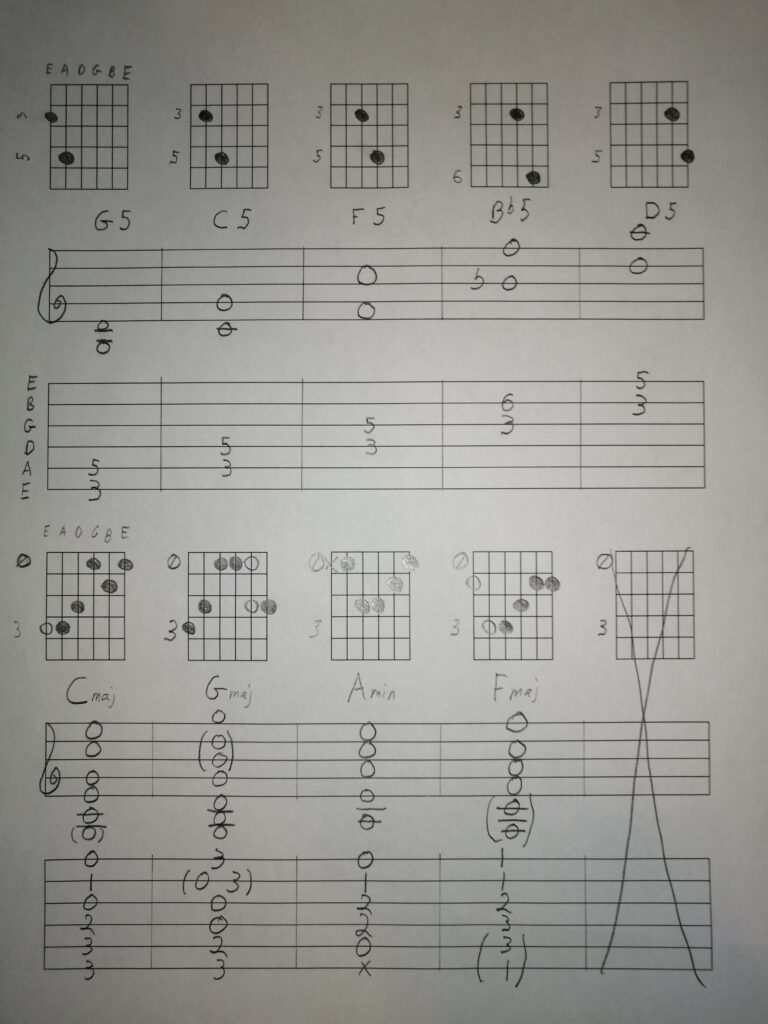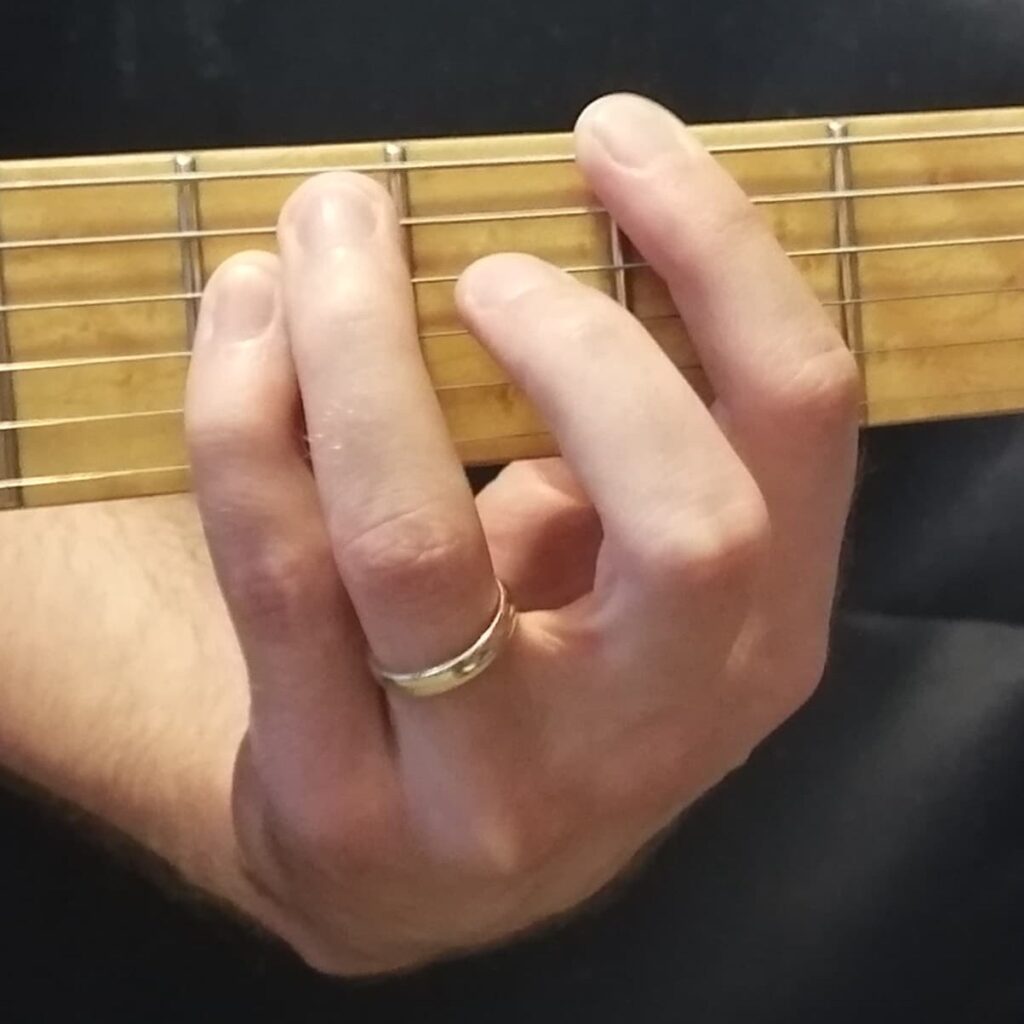A lot of people that are starting to dabble in writing their own material often come up with the questions: “What does it mean when there’s a note name and then 5 after it like C5 or G5?” and “What is a 1-5-6-4 song and how do I write one?”
They’re both great questions that require just a little bit of theory to properly answer – we won’t get into neapolitan 6 chords or 4th species counterpoint here, we’re going pretty bare-bones with the theory approach… this time.
“What does C5 mean?”
C5, in most cases, means a C power chord. That probably rings some bells for a lot of you already. A power chord is simply a root and a 5th played at the same time. So, in the case of C5, the power chord is C and G together. Let’s just put a list of all of the power chords (roots and 5ths) below and we’ll put the enharmonic equivalents* in italics.
*Examples of enharmonic notes are A# and Bb, C# and Db, F# and Gb, etc. They appear and sound the same on the piano.
See image:

- C5 = C G
- C#5 = C# G#
- Db5 = Db Ab
- D5 = D A
- D#5 = D# A#
- Eb5 = Eb Bb
- E5 = E B
- F5 = F C
- F#5 = F# C#
- Gb5 = Gb Db
- G5 = G D
- G#5 = G# D#
- Ab5 = Ab Eb
- A5 = A E
- A#5 = A# E#* “E#” would be “F” on the keyboard
- Bb5 = Bb F
- B5 = B F#
Check out the image at the end of the next section for notation, tab and fingering (for guitar) on how to play power chords as well as the chords for the 1-5-6-4 song we’re about to write.
What is a 1-5-6-4 song and how do I write one?
First off, you need to know what those numbers mean. They are referring to chords built on scale degrees based on the major scale. We will use concert C major to discuss this and we’ll put 1-5-6-4 in italics.
- 1 = C major
- 2 = D minor
- 3 = E minor
- 4 = F major
- 5 = G major
- 6 = A minor
- 7 = B diminished
Without getting too far into theory, a chord is made up by stacking thirds or every other note in a major/minor scale. So “C major” is made up of C E G, “A minor” is made up of A C E, etc. You can figure this by counting the keys on the piano using the above image. C major is an easy place to start because it uses only white keys on a piano/keyboard.
Let’s move on for now and discuss how to make a song using the chords C major (1), G major (5), A minor (6), and F major (4).
The sequence 1-5-6-4 is called a chord progression. We’re going to use only the chords 1-5-6-4 to make a song.
Before we get to the song though, we could use some lyrics. A song isn’t a song without singing. If there’s no singing/lyrics, then it can be called a tune, among other things.
Let’s write this one about writing a 1-5-6-4 song and some things you can do in it:
Verse
I’m sittin’ here tryin’ to think
Of all the things I can write about
Instead of getting lost
I’ll stay inside I won’t go out
Keepin’ it simple, keepin’ it sweet
Makin’ it possible to tap your feet
To the simple fact that
We are playing
So join along, we’ll build the chords
And figure out what we have in store
You can predict it, and I will admit it
We’re headin’ to the chorus for some
Chorus
More time to sing
More time for everything
Stretch out the words
Harmonize in thirds
Verse
Then bring it back, keep it low
Make some vocals just like so
Don’t need to complicate it
Life’s already complicated
Remember to start to build back up
To keep the energy moving on
Make sure to carry them
Right on to the chorus for some
Chorus
More time to sing
More time for everything
Stretch out the words
Harmonize in thirds
Bridge
These are the same chords as before
But I rearranged them
Now it’s 6-4-1-then 5
Bridges are usually the part
Where the colour changes
Most cases it’s just the same
It just rearranges
Chorus
More time to sing
More time for everything
Stretch out the words
Harmonize in thirds
More time to sing
More time for everything
Stretch out the words
Harmonize in thirds
Start to fade it out
Keep the melody
Random words right here
Watch out for that tree
Now that we have the lyrics, let’s look at the image I was talking about with some power chords, the chords I used, and listen to the song I made with them.

From top to bottom going line-by-line:
- Power chord shapes on the guitar – the letters/note names written refer to the strings… 6 letters/note names, 6 strings.
- Standard notation of how those chords appear on a staff. *Lines from bottom to top are E G B D F and the spaces from bottom to top spell F A C E
- Guitar tab for the fingerings of the notes on a guitar
- The chord fingerings for the chords used in this song
- How those chords are written on the staff
- How those chords are tabbed out (brackets are optional/options)
Here’s the song:
How was I able to make this so quickly?
Practice. I’ve practiced playing all of the instruments you hear, and I’ve practiced writing all of the parts for the instruments you hear. Studying song form and structure helps for making your own because they’re, more than less, blueprints for making your own material. Furthermore, practice with a metronome, practice clapping rhythms and playing drums on your legs, and try to learn melodies and songs by ear.
What was my writing process?
I started out with the thought, “I’m going to write a song with the progression 1-5-6-4 and I want the lyrics to be about writing a song with the progression 1-5-6-4” which provided me parameters I could work within. You’ll find that setting parameters or limiting your options will help you make decisions and can actually inspire creativity.
After the lyrics, I began to play the progression and find ways to fit those words into it. You could either write the melody first and put lyrics to that – as kind of a fun puzzle game – or you could write the lyrics first and then fit them to the music by finding rhythmic and melodic patterns that suit your musical progression and theme. I did the latter.
I used a basic form of Verse – Chorus – Verse – Chorus – Bridge – Chorus and used the last line of each Verse as a kind of shortened pre-chorus or way to lead into the chorus.
I gradually introduced the instruments and how much of each chord I used on the guitar. I started with just the power chords (C5, G5, A5, F5) and then gradually filled out the chords to those in the above image. Choruses are generally the “anthem” section of songs, so I had full open chords that I strummed (see here for a discussion on strumming) for a more filled out sound.
The lyrics help to explain how to frame a song, as well as a lot of the writing process for a typical 1-5-6-4 song.
Parting thoughts
When writing a song or piece of music, don’t expect to write a masterpiece your first time, 300th time, or ever. The point is to create something that means something to you and/or serves a purpose. The beauty of art is that, even if you wrote a song for one purpose, people’s interpretation varies as wildly as each of our own personalities. So there’s no limit to how people can interpret your music.
Have fun. Be kind to yourself. Write poems and see if you can sing those over a chord progression or backing track you make yourself or find on YouTube. Practice what you want to become better at. Sometimes just writing “I don’t know what to write about” is enough to get the creative juices flowing.
Thanks for your time and I hope you’ve had as much fun reading this as I had writing it.
If you have any questions then you’re free to contact me or leave a comment below.
See you in the practice room and all the best,
– Matt

So much info Matt, I enjoyed it. Loved the song. Thanks for sharing
Pingback: When life gets you down, write about it: Part 2 – Matt Whitehead Music
Pingback: How can I make a song that mixes inspiration and themes? – Matt Whitehead Music
Pingback: How can I combine styles into an original track that feels new to me? – Matt Whitehead Music
Pingback: How can I make a love song? – Matt Whitehead Music
Pingback: How can I make a demo without vocals? – Matt Whitehead Music